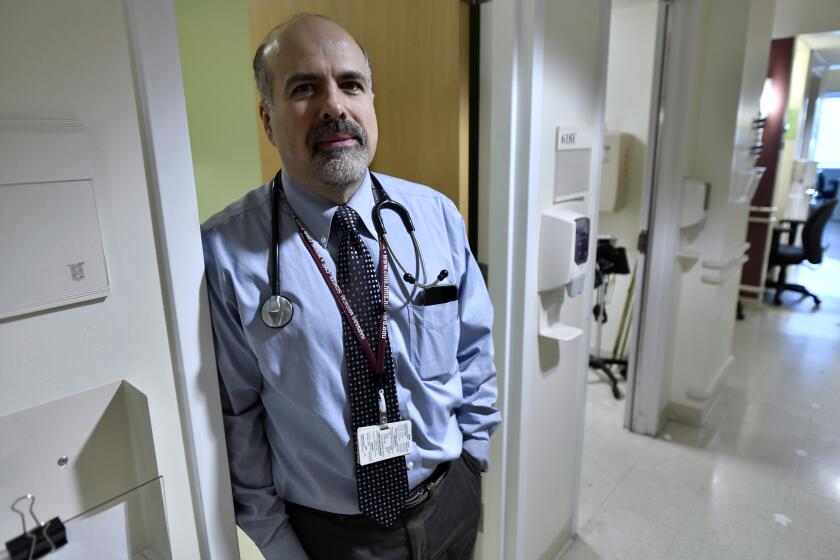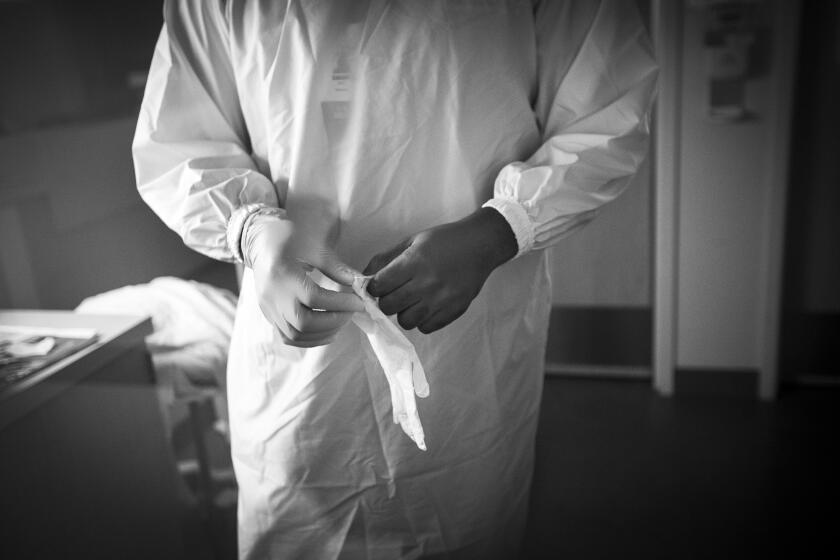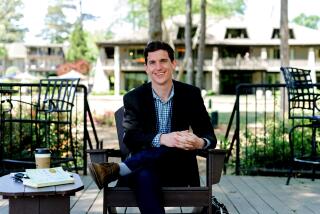How doctors use stories to help them cope with the coronavirus crisis
- Share via
Dr. Christopher Travis, an intern in obstetrics-gynecology, has cared for patients with COVID-19 and performed surgery on women suspected of being infected with the coronavirus. But the patient who arrived for a routine prenatal visit wearing two masks and gloves had a problem that wasn’t physiological.
“She told me, ‘I’m terrified I’m going to get this virus that’s spreading all over the world,’” he said of the March encounter. She was also worried that the coronavirus would hurt her baby, he added.
Travis, who practices at the Los Angeles County-USC Medical Center, told the woman he knew she was scared, and he tried to assure her she was safe and could trust him.
By asking many questions and carefully listening to her answers, Travis was exercising the craft of narrative medicine. It’s a discipline in which doctors and nurses use the principles of literature and art to better understand patients’ stories and incorporate them into their practices.
“How do we do that really difficult work during the pandemic without it consuming us so we can come out ‘whole’ on the other end?” Travis said. Narrative medicine, which he studied at Columbia University, has helped him be aware of his own feelings, reflect more before reacting, and view challenging situations calmly, he said.
The first graduate program in narrative medicine was created at Columbia University in 2009 by Dr. Rita Charon. The practice has gained wide influence since, as evidenced by the dozens of narrative medicine essays published in in the Journal of the American Medical Assn. and its sister journals.
Learning to be storytellers also helps clinicians communicate better with nonprofessionals, said Dr. Louise Aronson, a writer and geriatrician who directs the medical humanities program at UC San Francisco. It may be useful to reassure patients — or to motivate them to follow public health recommendations.
“Tell them a story about having to intubate a previously healthy 22-year-old who’s going to die and leave behind his first child and new wife, and then you have their attention,” Aronson said. “At the same time, telling that story can help the health professional process their own trauma and get the support they need to keep going.”
Teaching storytelling to doctors
This fall, the Keck School of Medicine of USC will introduce the country’s second master’s program in narrative medicine. The subject also will be part of the curriculum in the new Kaiser Permanente Bernard J. Tyson School of Medicine in Pasadena, which opens its doors July 27 with its first class of 48 students.
Narrative medicine trains physicians to care about patients’ singular, lived experiences, and how illness is really affecting them, said Dr. Deepthiman Gowda, assistant dean for medical education at the new Kaiser Permanente school. The training may entail a close group reading of creative works such as poetry or literature, or watching dance or a film, or listening to music.
Gowda said there’s also “real, intrinsic value” for patients because a doctor isn’t only being trained to care about the body and medications.
“Literature in its nature is a dive into the experience of living — the triumphs, the joys, the suffering, the anxieties, the tragedies, the confusions, the guilt, the ecstasies of being human, of being alive,” he said. “This is the training our students need if they wish to care for persons and not diseases.”
The monitor by the patient’s bed wailed, prompting a harried physician to rush into the ICU.
Dr. Andre Lijoi, a geriatrician at WellSpan York Hospital in Pennsylvania, recently led a virtual session for 20 front-line nurse practitioners who work in nursing homes. Two volunteers recited Mary Oliver‘s 1986 poem “Wild Geese,” which reads, “Tell me about despair, yours, and I will tell you mine. Meanwhile the world goes on.”
Sharing the poet’s words helped the nurses relieve their pent-up tensions, enabling them to express their feelings about life and work amid the COVID-19 pandemic, Lijoi said.
One participant wrote: “As the world goes on around me I mourn seeing my aging parents, planning my daughter’s wedding, and missing my great niece’s baptism. I wonder, when will life be ‘normal’ again?”
Processing fear to provide better care
Dr. Naomi Rosenberg, an emergency room physician at Temple University Hospital in Philadelphia, studied narrative medicine at Columbia and teaches it at Temple’s Lewis Katz School of Medicine. The discipline helps her “metabolize” what she takes in while caring for COVID-19 patients, including the fear that comes with having to enter patients’ rooms alone in protective gear, she said.
The training helped her counsel a worried woman who couldn’t visit her sister because the hospital, like others around the country, wasn’t allowing relatives to visit coronavirus-infected patients.
“I’d read stories of Baldwin, Hemingway and Steinbeck about what it feels like to be afraid for someone you love, and recalling those helped me communicate with her with more clarity and compassion,” Rosenberg said. (After a four-day crisis, the sister recovered.)
Close readings can also help students understand the various ways metaphor is used in the medical profession, for good or ill, said Dr. Pamela Schaff, who directs the new narrative medicine program at USC.
Recently, Schaff led third-year medical students through a critical examination of a journal article that described medicine as a battlefield. The analysis helped student Andrew Tran understand that describing physicians as “warriors” could “promote unrealistic expectations and even depersonalization of us as human beings,” he said.
Something similar happens in the militarized language used to describe cancer, Tran added: “We say, ‘You’ve got to fight,’ which implies that if you die, you’re somehow a failure.”
A photographer documenting the coronavirus fight at Martin Luther King Jr. Community Hospital recalls her mentor, a nun who like hospital staff embodied care and compassion.
In the real world, doctors are often narrowly focused, devoting most of their attention to a patient’s chief complaint. They listen to patients on average for only 11 seconds before interrupting them, according to a 2018 study in the Journal of General Internal Medicine. Narrative medicine seeks to change that.
While listening more carefully may add one more item to a physician’s lengthy “to-do” list, it could also wind up saving time, Schaff said.
“If we train physicians to listen well, for metaphor, subtext and more, they can absorb and act on their patients’ stories even if they have limited time,” she said.
Telling the patient’s whole story
In practice, narrative medicine has diverse applications. Modern electronic health records, with their templates and prefilled sections, can hamper a doctor’s ability to create meaningful notes, Gowda said. But doctors can counter that by writing notes in language that makes a patient’s struggles come alive, he said.
The Kaiser Permanente school’s curriculum will incorporate a different patient story each week to frame students’ learning. “Instead of, ‘This week, you will learn about stomach cancer,’ we say, ‘This week, we want you to meet Mr. Cardenas,’” Gowda said. “We learn about who he is, his family, his situation, his symptoms, his concerns. We want students to connect medical knowledge with the complexity and sometimes messiness of people’s stories and contexts.”
In preparation for the school’s opening, Gowda and a colleague have been running Friday lunchtime sessions on mindfulness and narrative medicine for both faculty and staff.
The meetings might include a collective, silent examination of a piece of art, followed by a discussion and shared feelings, said Dr. Marla Law Abrolat, a Permanente Medicine pediatrician in San Bernardino and a faculty director at the new school.
“Young people come to medicine with bright eyes and want to help, then a traditional medical education beats that out of them,” Abrolat said. “We want them to remember patients’ stories that will always be a part of who they are when they leave here.”
Stephanie Stephens writes for Kaiser Health News (KHN), which publishes California Healthline, an editorially independent service of the California Health Care Foundation. KHN is not affiliated with Kaiser Permanente.








